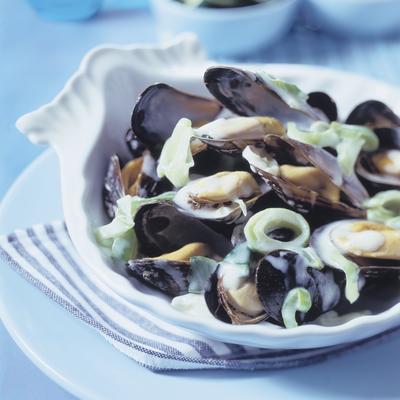The healthiest fish to eat!
-
Fish is tasty, fish is healthy. We all know that. Since fish is available everywhere, from frozen to fresh, there is nothing in the way of putting it on the table for at least 2 weeks. But why is fish healthy? Yes, the famous healthy fatty acids that are mainly in fresh fish, that's completely true. But are there any other reasons? And what are the benefits for your body? Read on quick!
-
Fish is tasty, fish is healthy. We all know that. Since fish is available everywhere, from frozen to fresh, there is nothing in the way of putting it on the table for at least 2 weeks. But why is fish healthy? Yes, the famous healthy fatty acids that are mainly found in fresh fish, that's completely true. But are there any other reasons? And what are the benefits for your body? Read on quick!
Fish, fish and more fish
-
It is clear that fish should be on the menu regularly. Yet we eat relatively less fish than the neighboring countries. Only one fifth of the Dutch eat, as recommended by the nutrition center, properly put fish on the menu twice a week. This is an average, because the figures are even lower for young people and children in particular: Only 8% of this group eats fish twice a week. Despite the fact that the Dutch are generally at the forefront of a healthy diet, they do not eat enough fish. How is that possible?
-
It is clear that fish should be on the menu regularly. Yet we eat relatively less fish than neighboring countries. Only one fifth of the Dutch eat, as recommended by the nutrition center, properly put fish on the menu twice a week. This is an average, because the figures are even lower for young people and children in particular: Only 8% of this group eats fish twice a week. Despite the fact that the Dutch are generally at the forefront of a healthy diet, they do not eat enough fish. How is that possible?
-
Recently, a study was conducted into the reason why relatively little fish is eaten in the Netherlands. In part the result is not very surprising, but some points make your eyebrows a little frown. In short, unknown makes unloved. The results of the investigation:
-
Recently, a study was conducted into the reason why relatively little fish is eaten in the Netherlands. Partly the result is not very surprising, but some points make your eyebrows a little frown. In short, unknown makes unloved. The results of the investigation:
-
 11 minMain dishpeanut oil, tofu stir-fry cubes finely seasoned, stir fry sauce sweet and sour, thick noodles, carrot julienne, beetroot julienne, yellow bell pepper, watercress,rainbow salad with tofu
11 minMain dishpeanut oil, tofu stir-fry cubes finely seasoned, stir fry sauce sweet and sour, thick noodles, carrot julienne, beetroot julienne, yellow bell pepper, watercress,rainbow salad with tofu -
 45 minMain dishRed cabbage, mild olive oil, quinoa plus, forest outing, lemon, sesame oil, soy sauce less salt, Bio Today tahini white in pot, tap water,grilled red cabbage with quinoa salad
45 minMain dishRed cabbage, mild olive oil, quinoa plus, forest outing, lemon, sesame oil, soy sauce less salt, Bio Today tahini white in pot, tap water,grilled red cabbage with quinoa salad -
 30 minDessertBrie, Roquefort, port salut, gruyere, Camembert, walnut, garlic, thyme, honey, grape, baguette, Red onion, red grape, raisins, Red wine, Red wine vinegar, Brown sugar,generous cheese plate with onion marmalade
30 minDessertBrie, Roquefort, port salut, gruyere, Camembert, walnut, garlic, thyme, honey, grape, baguette, Red onion, red grape, raisins, Red wine, Red wine vinegar, Brown sugar,generous cheese plate with onion marmalade -
 30 minDessertFull Milk, whipped cream, macaroon, custard powder, vanilla sugar, sugar, protein, amaretto, almond liqueur, basic recipe cooking pears,macaroon pastry with casserole
30 minDessertFull Milk, whipped cream, macaroon, custard powder, vanilla sugar, sugar, protein, amaretto, almond liqueur, basic recipe cooking pears,macaroon pastry with casserole
-
At least 32% of the Dutch think fish is too expensive for regular consumption.
-
So the price of fish is the biggest stumbling block. It is true that fresh fish is more expensive than meat. For example, if you take the cheapest type of meat, minced meat, you can buy this in the offer for about 4 euros per kilo. The cheapest fish, for example, is the Pangasius fillet. This one costs almost 8 euros on offer. These are prices for fresh products. But if you look at frozen fish, prices quickly drop. You can then buy the same Pangasius fillet for less than 5 euros, and it comes close to minced meat. If we then look at the top of the market, you can buy a salmon fillet for 26 euros per kilo, for example. A lot of money, but if you compare that with an expensive type of meat, premium steak, you also quickly pay 27 euros per kilo. Like meat, you can make fish as cheap or as expensive as you want.
-
So the price of fish is the biggest stumbling block. It is true that fresh fish is more expensive than meat. For example, if you take the cheapest kind of meat, minced meat, you can buy this in the offer for about 4 euros per kilo. The cheapest fish, for example, is the Pangasius fillet. This one costs almost 8 euros on offer. These are prices for fresh products. But if you look at frozen fish, prices quickly drop. You can then buy the same Pangasius fillet for less than 5 euros, and it comes close to minced meat. If we then look at the top of the market, for example, you can buy a salmon fillet for 26 euros per kilo. A lot of money, but if you compare that with an expensive type of meat, premium steak, you also quickly pay 27 euros per kilo. Like meat, you can make fish as cheap or as expensive as you want.
-
A quarter of the Dutch do not like to clean fish.
-
 5 minDrink without alcoholbananas, cool fresh apple-pear raspberry juice, Soy drink vanilla,soy fruit shake
5 minDrink without alcoholbananas, cool fresh apple-pear raspberry juice, Soy drink vanilla,soy fruit shake -
 20 minMain dishsauerkraut, sticking potato, liquid baking product, half-to-half minced, Spice meatballs, pineapple, olive oil, liquid baking product,gratin sauerkraut dish with minced meat
20 minMain dishsauerkraut, sticking potato, liquid baking product, half-to-half minced, Spice meatballs, pineapple, olive oil, liquid baking product,gratin sauerkraut dish with minced meat -
 40 minMain dishlemongrass, fresh ginger, Red peppers, onions, tomato cubes, fresh cod fillet, coriander, oil, ground turmeric (koenjit), coconut milk, salt,fish in creamy coconut sauce
40 minMain dishlemongrass, fresh ginger, Red peppers, onions, tomato cubes, fresh cod fillet, coriander, oil, ground turmeric (koenjit), coconut milk, salt,fish in creamy coconut sauce -
 15 minSide dishsweet potato, soft goat cheese, egg, spring / forest onion,stuffed sweet potato with egg
15 minSide dishsweet potato, soft goat cheese, egg, spring / forest onion,stuffed sweet potato with egg
-
If you like a fish, but don't want to clean it, it is an idea to buy (frozen) fillet. You can buy ready-made fillets or have your fresh fish fillet by the fishmonger.
-
If you like a fish, but don't want to clean it, it is an idea to buy (frozen) fillet. You can buy ready-made fillets, or have your fresh fish fillet by the fishmonger.
-
A smaller part does not like the smell of fish during preparation.
-
A smaller proportion does not like the smell of fish during preparation.
-
The moment fish starts to smell, it is no longer fresh. Fresh fish does not smell, and over time the unpleasant odor starts to spread. When you visit a good fishmonger, you don't smell anything: A sign of freshness!
-
The moment fish starts to smell, it is no longer fresh. Fresh fish does not smell, and over time the unpleasant smell begins to spread. When you visit a good fishmonger, you don't smell anything: A sign of freshness!
-
 20 minMain dishTasty vine tomato, (olive oil, fresh basil, onion, garlic, Parmigiano Reggiano, zucchini spaghetti, pumpkin spaghetti, mini buffalo mozzarella,lukewarm pumpkin and zucchini spaghetti
20 minMain dishTasty vine tomato, (olive oil, fresh basil, onion, garlic, Parmigiano Reggiano, zucchini spaghetti, pumpkin spaghetti, mini buffalo mozzarella,lukewarm pumpkin and zucchini spaghetti -
 15 minSide dishtraditional olive oil, curry powder, wheat flour, coconut milk, sambal oelek, chicken broth tablet, water, fresh mango,curry sauce with mango
15 minSide dishtraditional olive oil, curry powder, wheat flour, coconut milk, sambal oelek, chicken broth tablet, water, fresh mango,curry sauce with mango -
 30 minMain dishtraditional olive oil, lean ground beef, frozen Mexican wok vegetables, salsa sauce mild, taco shell, grated young cheese, creme fraiche,Mexican vegetable in tacos
30 minMain dishtraditional olive oil, lean ground beef, frozen Mexican wok vegetables, salsa sauce mild, taco shell, grated young cheese, creme fraiche,Mexican vegetable in tacos -
 95 minMain dishmaize chicken, lemon, coarse sea salt, pepper, extra virgin olive oil, garlic, thyme, zucchini, tomatoes (small to), black olives without pit,provençal chicken with zucchini and tomatoes
95 minMain dishmaize chicken, lemon, coarse sea salt, pepper, extra virgin olive oil, garlic, thyme, zucchini, tomatoes (small to), black olives without pit,provençal chicken with zucchini and tomatoes
-
The reasons that emerge from the research all have to do with the fact that there is not enough knowledge about fish in general and how to prepare them. A pity, because fish is tasty and healthy too.
Why is fish so healthy?
-
Fish is so healthy because it contains many vitamins, proteins and minerals. The most famous health benefit is of course the presence of good fatty acids, especially the famous Omega-3 fatty acids. Let's list this one by one:
Vitamins in fish
-
Fish contains many types of vitamins, especially vitamin A, vitamin D and vitamin B12. The first two types, the vitamins A and D, are mainly found in the fatty fish.
-
Vitamin A is very important for your eyes, among other things. Without vitamin A you will inevitably have to deal with very nasty eye ailments. Vitamin D is an important substance for the functioning of your brain, among other things. Of great importance for your bones and teeth. Vitamin D enables calcium to bind to your bones and teeth. Without vitamin D, all the calcium in your body makes no sense at all, and will leave the body just as quickly. Vitamin B12 is very important for the nervous system.
Minerals in fish
-
It is known that without the necessary minerals we are unable to live. This is shown, among other things, by the fact that minerals are, among other things, the â € taxiâ € ™ for the transport of oxygen in our body. Not only important for your overall health, but also especially for the functioning of your nerves and muscles. Did you know that we need a range of about 20 minerals per day to function properly?
-
The main mineral we find in fish is iodine. Iodine is important for the efficient functioning of, among other things, your thyroid gland due to its natural anti-inflammatory effect. Many types of fish also contain the mineral Zinc. This mineral helps your immune system to build and maintain a good resistance. It is no secret that a good resistance in turn prevents you from suffering from all kinds of small and large ailments.
-
 25 minSmall dishflour, frozen puff pastry, egg, milk, walnut, mature cheese, paprika, dried Provençal herbs,puff pastry-sticks
25 minSmall dishflour, frozen puff pastry, egg, milk, walnut, mature cheese, paprika, dried Provençal herbs,puff pastry-sticks -
 20 minSide dishEggs, lettuce, parsley, olive oil (extra virgin), tarragon vinegar, salt and freshly ground pepper,lettuce with egg dressing
20 minSide dishEggs, lettuce, parsley, olive oil (extra virgin), tarragon vinegar, salt and freshly ground pepper,lettuce with egg dressing -
 15 minSmall dishbaking flour, peanut oil, flat leaf parsley,ar'nabit mi'li
15 minSmall dishbaking flour, peanut oil, flat leaf parsley,ar'nabit mi'li -
 15 minAppetizerScottish salmon fillet, butter or margarine, fresh dill, creme fraiche, dry white wine, arugula lettuce melange, pan tostado,baked salmon with white-wine sauce
15 minAppetizerScottish salmon fillet, butter or margarine, fresh dill, creme fraiche, dry white wine, arugula lettuce melange, pan tostado,baked salmon with white-wine sauce
Fatty acids in fish
-
The recommendation of the nutrition center to eat two servings of fish per week is not unrealistic. This is enough to get the necessary amount of fatty acids, the so-called fish oil fatty acids. We know this better under the name Omega-3.
-
Omega-3 is indispensable for many processes in the body:
-
 25 minMain dishbalsamic vinegar, garlic, steak, Spaghetti, traditional olive oil, fresh green olive tapenade, arugula, Parmigiano Reggiano,spaghetti with steak and arugula
25 minMain dishbalsamic vinegar, garlic, steak, Spaghetti, traditional olive oil, fresh green olive tapenade, arugula, Parmigiano Reggiano,spaghetti with steak and arugula -
 15 minAppetizerfennel bulb, arugula, red pointed pepper, black agnus carpaccio (a 100 grams), capers,black angus carpaccio with fennel
15 minAppetizerfennel bulb, arugula, red pointed pepper, black agnus carpaccio (a 100 grams), capers,black angus carpaccio with fennel -
 35 minMain dishsweet potatoes, salad onion, garlic, cooking dairy, grated cheese for vegetable gratin, almond shavings, peanut oil, breaded schnitzels, Broccoli,crispy schnitzel with sweet potato gratin and broccoli
35 minMain dishsweet potatoes, salad onion, garlic, cooking dairy, grated cheese for vegetable gratin, almond shavings, peanut oil, breaded schnitzels, Broccoli,crispy schnitzel with sweet potato gratin and broccoli -
 30 minMain disholive oil, onion, tomato, risotto rice, laurel leaf, thyme, saffron, turmeric, fish stock of 1 tablet, mixed seafood, mixed whitefish fillet, mussel, lemon,fish paella from the oven
30 minMain disholive oil, onion, tomato, risotto rice, laurel leaf, thyme, saffron, turmeric, fish stock of 1 tablet, mixed seafood, mixed whitefish fillet, mussel, lemon,fish paella from the oven
-
This last one is a very important one, but I have to nuance that a bit. With just one Omega-3 you will not get the intended effect. Omega-3 is largely dependent on Omega-6. These two must be present in your body in the correct proportion. If you want to know more about this, read the article: Omega-3 and Omega-6: The importance of the right balance Â
The best fish to eat
-
Although almost all edible fish species are good for health, they should make a small distinction. There are types of fish that contribute little or nothing to health, and there are types of fish that almost belong to the category â € ˜ superfoods â € ™.
-
Let's take a closer look at the 4 healthiest fish species:
Fatty fish
-
This one is at the top of the list because oily fish contains the most nutrients. Especially vitamin A and Vitamin D, and of course not to forget the Omega-3. Examples of fatty fish are, for example, herring, mackerel, tuna and salmon. Please note that fresh fish is better than fish from a can. It is also better to eat wild fish than the artificially bred varieties. It's no problem at all to eat one of these fish twice a week.
Crab, lobster, shrimp
-
These fish were previously always on the penalty box, because science always assumed that they were responsible for increased cholesterol. But recent research has shown that the fatty acids influence the cholesterol, and not the cholesterol itself which is absorbed through the diet. Besides, there is a lot of HDL cholesterol in these fish, the good cholesterol that cleans your blood from the bad cholesterol, the LDL cholesterol.
Shellfish
-
The same story applies to this species as to shrimp, crab and lobster. Consider, for example, serving razor shells, clams, scallops, oysters or mussels. But make sure you eat everything in moderation. Excess harm, especially in this case.
Lean fish
-
The lean fish contains, in contrast to the oily fish, significantly less healthy Omega-3. For that reason, this is also in fourth place. But the lean fish also remains healthy and can be taken for variety if you regularly eat fatty fish. Consider, for example, whiting, haddock, Talapia, coalfish, garfish, cod, trout, perch, zander or sole. All delicious fish and very healthy, even though it contains a little less Omega-3.
-
 15 minMain dishgreen tagliatelle, garlic, Red pepper, olive oil, tomato cubes, cocktail shrimp, mixed salad, vinaigrette,spicy tagliatelle with shrimps
15 minMain dishgreen tagliatelle, garlic, Red pepper, olive oil, tomato cubes, cocktail shrimp, mixed salad, vinaigrette,spicy tagliatelle with shrimps -
 50 minMain dishsomething crumbly potatoes, sauerkraut natural, tomato paste, sambal oelek, bacon, semi-skimmed milk, unsalted butter, Gelderse smoked sausage,Sauerkraut with smoked sausage
50 minMain dishsomething crumbly potatoes, sauerkraut natural, tomato paste, sambal oelek, bacon, semi-skimmed milk, unsalted butter, Gelderse smoked sausage,Sauerkraut with smoked sausage -
 20 minBreakfastrucola lettuce, bunch onion, roasted red peppers in pot, traditional olive oil, medium sized egg, fresh cream, grated mature cheese, butter,creamy cheese omelet with arugula
20 minBreakfastrucola lettuce, bunch onion, roasted red peppers in pot, traditional olive oil, medium sized egg, fresh cream, grated mature cheese, butter,creamy cheese omelet with arugula -
 25 minMain dishceleriac, floury potatoes, olive oil, beef finches, onion, Apple juice, gravy natural, dairy spread,beeffinch with sweet apple gravy
25 minMain dishceleriac, floury potatoes, olive oil, beef finches, onion, Apple juice, gravy natural, dairy spread,beeffinch with sweet apple gravy
Warning for pregnant women
-
For pregnant women and people with poor health, it is wise to avoid certain types of fish. Despite all its health benefits, some varieties also contain mercury, an annoying metal that will never leave your body. This mercury enters the fish through environmental pollution, which is our own fault. The most affected fish species are bluefin tuna and Chilean Sea bass. It is also better to leave the common sea bass.
Conclusion
-
We can conclude from this that fish is very healthy, and that it should be on everyone's table twice a week. On the internet you can find a lot of information about how to prepare (fresh) fish. And indeed, prefer wild, fatty fish that you can simply buy from the fishmonger around the corner.
-
 25 minMain dishthin bacon strips, onion, chicken fillet, smoked paprika, chestnut mushrooms, traditional olive oil, chilled little newborns, fresh carrots and snow peas,free-range chopsticks with mixed vegetables
25 minMain dishthin bacon strips, onion, chicken fillet, smoked paprika, chestnut mushrooms, traditional olive oil, chilled little newborns, fresh carrots and snow peas,free-range chopsticks with mixed vegetables -
 15 minSnackflatbread, Mango Chutney, smoked duck breast, cress,oriental duck
15 minSnackflatbread, Mango Chutney, smoked duck breast, cress,oriental duck -
 20 minMain dishmussel, butter, leeks, White wine, water, creme fraiche,normandy mussels in cream sauce
20 minMain dishmussel, butter, leeks, White wine, water, creme fraiche,normandy mussels in cream sauce -
 65 minDessertsugar, vanilla bean, oranges, almond shavings, butter, Eggs, vanilla sugar, self-raising flour,orange-almond pie
65 minDessertsugar, vanilla bean, oranges, almond shavings, butter, Eggs, vanilla sugar, self-raising flour,orange-almond pie
-
Do you regularly have fish on your menu? Or do you not like this… It is greatly appreciated if you leave your experiences and thoughts in a comment!